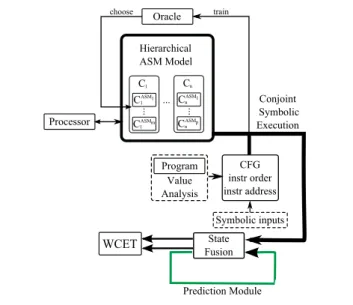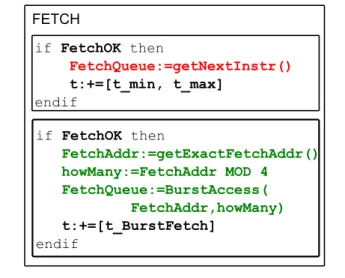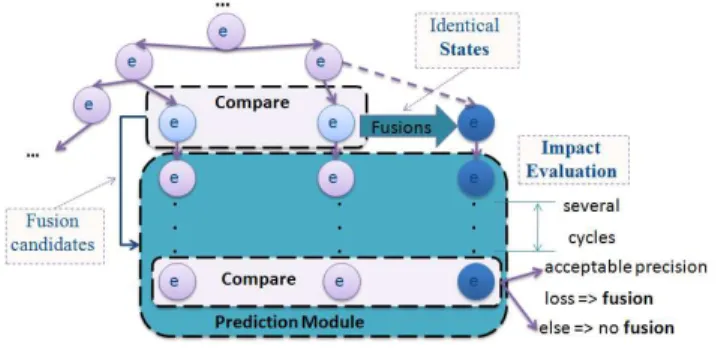HAL Id: hal-01214943
https://hal.archives-ouvertes.fr/hal-01214943
Submitted on 13 Oct 2015
HAL is a multi-disciplinary open access
archive for the deposit and dissemination of
sci-entific research documents, whether they are
pub-lished or not. The documents may come from
teaching and research institutions in France or
L’archive ouverte pluridisciplinaire HAL, est
destinée au dépôt et à la diffusion de documents
scientifiques de niveau recherche, publiés ou non,
émanant des établissements d’enseignement et de
recherche français ou étrangers, des laboratoires
Adaptable and Precise Worst Case Execution Time
Estimation Tool
Vladimir-Alexandru Paun, Bruno Monsuez
To cite this version:
Vladimir-Alexandru Paun, Bruno Monsuez. Adaptable and Precise Worst Case Execution Time
Es-timation Tool. Languages, Compilers, Tools and Theory for Embedded Systems WiP, Jun 2012,
Beijing, China. �hal-01214943�
Adaptable and Precise
Worst Case Execution Time Estimation Tool
Vladimir-Alexandru Paun
UEI, ENSTA ParisTech Paris, France
paun@ensta-paristech.fr
Bruno Monsuez
UEI, ENSTA ParisTech Paris, France
monsuez@ensta-paristech.fr
Abstract
Real-time systems are everyware. When they are integrated into safety-critical systems, the verification of their prop-erties becomes a crucial part. Besides the growth in com-plexity of the embedded systems, platforms are getting more and more heterogeneous. Being able to validate their non-functional properties is a complex and resource consuming task. One of the main reasons is that currently available so-lutions focus on delivering precise estimation through tools that are highly dependent on the underlying platform as in order to provide precise and safe results, the architecture of the system must be take into account. In this project we ad-dress these issues by developing a prototype that maintains a good level of precision while being adaptable to a variety of platforms by separating as much as possible the worst case execution time estimation stage from the hardware modeling aspects.
General Terms Hard Real-Time Systems, precision, safety, adaptability
Keywords WCET, Abstract State Machine, Symbolic Exe-cution
1.
Introduction
With regard to the respect of the timing constraints, real-time systems are classified in two categories: hard real-time sys-tems (the non respect of a deadline can lead to catastrophic consequences) and soft real-time systems (missing a dead-line can cause performance degradation and material loss). We analyze hard real-time systems that need precise and safe determination of the worst case execution time (WCET) bounds that are crucial in the certification process.
Tradi-[Copyright notice will appear here once ’preprint’ option is removed.]
tionally two approaches are used, namely dynamic and static methods [1], we only consider the latest as dynamic meth-ods, in the traditional sens, fail to deliver safe estimations for modern platforms that contain, for example, pipelines or cache memories and tend to greatly underestimate the WCET.
In order to give a safe estimation of the WCET, all the interactions and reachable states of the system must be an-alyzed or over approximated, hence the need of an analy-sis that takes into account the exact underlying architecture. We choose to separate as much as possible the modeling part from the analysis part in order to achieve the flexibil-ity needed to adapt to new hardware.
In our approach we start from the system’s model and the binary that will be executed on the final platform. An extension of the Symbolic Execution (SE) [2], the conjoint SE, will generate all the reachable states of the processor, under the supervision of a prediction module that will fusion identical and similar states in order to contain the state space explosion and give details regarding the global precision loss of the WCET estimation.
In the following we first take a look into the state of the art concerning timing analysis and we continue with the description of the high level architecture of our tool. Subsequently we take a closer look into the formal model used to simulate the hardware that gives us the edge in the adaptability of our tool followed by a presentation of the WCET estimation steps and the transformations needed to contain the combinatorial explosion.
2.
Related works
Many of the available time analysis tools show a list of compatible hardware and present each new platform taken into account as a new feature. One of existing methods, OTAWA, introduced by Cass and Sainrat [4], differentiates itself by making a first step towards adaptability as it uses a parametrized model of a generic platform that can address a variety of architectures but nevertheless, the process is fairly difficult and the model lacks precision while it fails to cap-ture the precise behavior of the platform. AbsInt, one of the
leading WCET analyzers is also taking a step towards adapt-ability by apparently looking to use a SystemC description in order to generate an abstract model. The main issue is that the SystemC language has only recently come to be a stan-dard therefore descriptions of older hardware (mainly used in hard real-time systems) are not common. To our knowl-edge non of the other WCET tools have embraced the adapt-ability paradigm.
3.
The global architecture of the WCET
estimation tool
The two main entries of the tool are the processor model and the program binary, as depicted in Figure 1. The processor is regarded as the union of it’s components µP =
n
S
i=0
Ci
and modeled as a hierarchical timed abstract state machine, described further in the paper, that has the useful feature of enabling multiple definitions for a same component Ci. A
supervisor that we call the Oracle decides what abstraction level is best suited for the current context in order to optimize the precision to state explosion ratio. An external value ana-lyzer is used to obtain information regarding the instruction order, their addresses and the control flow graph of the pro-gram. Symbolic execution is used to symbolically execute each instruction of the program, meaning that each variable has initially a symbolic value (as we generally do not posses exact information on it’s value) that gets refined by accumu-lating all the informations and decisions taken during execu-tion. One of the advantages of this method is that it manages to simulate the interactions inside the processor in detail, for example capturing by construction the timing anomalies [5]. The SE generates all reachable states of the processor, mean-ing that we have to manage a rapidly increasmean-ing state space. Our fusion stage consists in merging as much states as possi-ble without affecting to much the precision of the estimation. We achieve this by using the prediction module that will first identify the states that are good candidates for merging and then estimate the impact of the fusion on the global analy-sis. After browsing and evaluating the processor’s states, the time corresponding to the worst path is selected.
4.
Timed Hierarchical Abstract State
Machines
4.1 Abstract State Machine Formalism
The sequential ASM Thesis, introduced in [6] proves the iso-morphic modeling of any algorithm. The sequential ASM algorithm consists of a set of rules applied to states in a sequence of steps assimilated to a run. States are struc-tures in the sense of first-order logic, with relations trated as Boolean-valued functions. A finite collection of function names having a fixed arity is called a vocabulary,Γ. A state S of vocabularyΓ is a non-empty set X, together with the
interpretation of all function names inΓ over X, therefore
holding the values of all the variables at a specific step.
Up-Processor Hierarchical ASM Model Program Value Analysis CFG instr order instr address Symbolic inputs State Fusion WCET Prediction Module Conjoint Symbolic Execution C1 C1ASM1 C1ASMm Cn CnASM1 CnASMp ... ... ... Oracle choose train
Figure 1. Global architecture of the WCET estimation tool
dates represent the simplest change that can occur to a state
by the change of the interpretation of a function at one par-ticular tuple of arguments. Let R be a rule that gives rise to a set of updates. In order to execute R at S all the updates are triggered in the corresponding update set. Thus we have the
update rule, the block rule, a sequence of transitions rules
that are executed simultaneously, the conditional rule if g
then R0else R1endif, etc. 4.2 Hierarchical Timed ASM
Possessing a precise and versatile model of the processor is very important. Nevertheless having access to an usable HDL code, is rarely the case for platforms used in hard real-time systems, that are fairly outdated, and even if it exists, their is no common, unified description language. Ideally we should use the description of the processor as an input and generate an usable model for the analysis. As the lack of availability and standardization makes the task impossible, the need to create a model for each platform is mandatory. This is one of the bottlenecks in the adaptability of current tools, and we consider that the modeling part should be therefore an separated straightforward engineering task that can be made on the fly and without disposing of precise knowledge with regard to the rest of the tool. Therefore we chose to use the abstract state machine, a method that bridges the gap between human understanding and formulation of real-world problems and the deployment of their algorithmic solutions, in our case, the modeling of the processor, that showed it’s efficiency as a specification method in numerous practical applications (e.g. see [7], [10]).
Using a human readable and machine executable lan-guage makes the difference when it comes to speeding up the process of the hardware description. However some impor-tant features were not included in the original version of the ASMs [6] like the timing aspects hence updates are
consid-ered immediate. Ouimet et all. [8] introduced the concept of durative actions by adding delays directly in the syntax; our approach is similar. In [9] a prototype of a simulator for re-active timed ASMs that verifies the respect of requirements specifications. Besides the timing aspects we enrich the orig-inal model with hierarchical feature that enables us to give different definitions on several abstraction levels of the same processor component.
The goal of hierarchical ASMs is to provide at any time during the analysis, the right level of abstraction in order to prevent the combinatorial explosion. We know that we do not always dispose of precise information during the analysis (e.g. data memory address, availability in the cache, etc.) therefore using the most precise description of the fetching mechanism, for example, would be useless, on the other hand, a less precise, more abstract, definition could help reduce the number of generated states.
The hierarchical definition of components integrates seamlessly into the ASM formalism. Basically, the oracle is an ASM module that imports all the needed function defi-nitions and exports the needed functions or rules. Each hier-archical module is defined as a control state ASM (cf. [10]) using in it’s condition the result from the oracle that decides which implementation is appropriate for the current context.
selected(Fetch1) and FetchOK Fetch1 rule selected(Fetch1) and FetchOK Fetch2 rule forall fetch in FETCHER
forall comp in uP
Select(DECODE) rule Select(FETCH) rule
...
Figure 2. The oracle and the fetcher modules
FETCH =
forall fetch ∈ FETCHER do FETCH1(fetch), FETCH2(fetch)
In Figure 3 we have two definition of the Fetch stage, the first one corresponding to the more abstract version that will typically be chosen if we have no precise information on the exact fetch address. Generally we have a family of abstraction for each component of the processor, αCi =
m S j=0 αj so that Ci αj → Cαj i . Let T(C αj i ) be the contribution FETCH if FetchOK then FetchQueue:=getNextInstr() t:+=[t_min, t_max] endif if FetchOK then FetchAddr:=getExactFetchAddr() howMany:=FetchAddr MOD 4 FetchQueue:=BurstAccess( FetchAddr,howMany) t:+=[t_BurstFetch] endif
Figure 3. Different definitions of the fetcher
of the abstract component to the global execution time. We must have T(Cαj
i ) w T(Ci).
5.
Conjoint Symbolic Execution
The use of SE to analyze the intra-processor interactions has been used with good results in [3], however the method suf-fers from the lack of a precise hardware model and inac-curate merging strategies that lead to important overestima-tions. The basic SE consists in replacing the variables with symbolic values and extending the operations in order to take this into account. The interpretation of the assignment rule is straightforward. Let p(pc) be Q, p(xi) be Eiand p(α ← β)
be the old p where the value of α is changed to β. A spe-cial treatment is applied to conditional instructions that use the pc to explore all the possible scenarios. The expressions conjoined in the pc are of form Q > 0 where Q is a
poly-nomial over symbolic values. Let R be this expression we thus have three possible cases: we can determine from the
pc that the condition is always true(pc ⊃ R and pc 6⊃ ¬R),
analogue for always false or we can not determine if the con-dition is true or false, pc ⊃ R and pc ⊃ ¬R, therefore the execution will continue along both branches, generating two new paths.
The first step of our conjoint SE deals with the program’s CFG that is regarded as an input for the processor’s model
SE.
6.
Smart State Fusion
One of the major drawbacks of the SE comes from its qual-ity of generating every feasible path, that for a real-life in-dustrial program generates a combinatorial explosion that is not obviously containable. What still remains challenging today is to handle this explosion while still remaining pre-cise enough. This translates to finding a way of eliminating some of the states, and we choose the technique of states fusion that will try to generate an abstract state capable of
capturing the respective states features, with regards to the goal, but remain as compact as possible. It has been proven in [11] that because of the finite number of states that a pro-cessor can have and because of the constrains generated by the execution contexts at a certain point we will have states that regardless of the different history, will generate identical or very similar new states. One major step in having precise fusions is to determine when to make them and what changes to apply. States can be of two types: identical, meaning that they have either all the elements that are the same, in this case we can suppose that an eventual fusion will not impact the precision of the analysis, or similar, some of the compo-nents are not the same so we proceed to another analysis to determine to which extent they are different. Therefore sim-ilar states can be strongly or weakly simsim-ilar, meaning that the impact of the fusion will be acceptable or not. For the instant this estimation is done dynamically by our predic-tion module. Its goal is to evaluate the impact in the future of a fusion by unrolling the tree for several steps (generally equal to the pipeline depth), continuing the execution along the paths before and after fusion and comparing the result. Further details about this technique can be found in [11].
Figure 4. The Dynamic Fusion - snapshot of the Prediction
Module
7.
Global algorithm
1. Start from the initial state: where all the components have the unknown value and pc is set to true
2. For every variable that we encounter and that we do not have the exact value, assign a symbolic value
3. Activate the first ASM model and then add the guard condition g to the pc
4. Choose from the oracle the appropriate version of the ASM modules
5. Compute the update set of the current step
6. Apply the update set (taking into account that some terms will have symbolic values)
7. Add the result of the update set to the global system state
8. Add the generated states to the collection of next states to be executed
9. Add the duration of the transition to the global time 10. Repeat from point 2. until the collection of next states is
empty
8.
Conclusions
The world of embedded software is no longer integrating simple hardware/software therefore critical systems are be-coming more and more difficult to prove and certify. The growth in complexity and variety increases the need of ver-satile analyze methods and adapted tools, that can easily and as costless as possible deal with a large panel of architec-tures. To this end we presented a novel approach that is able to respond to the evergrowing demands and to place itself into a real industrial context.
References
[1] R. Wilhelm, J. Engblom, A. Ermedahl, N. Holsti, S. Thesing, D. Whalley, G. Bernat, C. Ferdinand, R. Heckmann, T. Mitra, F. Mueller, I. Puaut, P. Puschner, J. Staschulat, P. Stenstrom The Worst-Case Execution Time Problem Overview of Methods and Survey of Tools, ACM Transactions on Embedded Computing
Systems (TECS), Volume 7, Issue 3, April 2008.
[2] T. Lundqvist and P. Stenstrom, An Integrated Path and Timing Analysis Method based on Cycle-Level Symbolic Execution, in
Real-Time Systems, Volume 17, 183-207, November 1999.
[3] T. Lundqvist, A WCET Analysis Method for Pipelined Microprocessors with Cache Memories, Goteborg, Sweeden, 2002.
[4] H. Cass and P. Sainrat, Otawa, A framework for experimenting WCET computations, ERTS06, 2006.
[5] J. Reineke, B. Wachter, S. Thesing, R. Wilhelm, I. Polian, J. Eisinger, and B. Becker, A vDefinition and Classification of Timing Anomalies, WCET06, 2006.
[6] Yuri Gurevich, Evolving Algebras 1993: Lipari Guide, Specifi-cation and Validation Methods, ed. E. Brger, Oxford University
Press, 1995, 9–36.
[7] University of Michigan, ASM homepage.
http://www.eecs.umich.edu/gasm/.
[8] M. Ouimet and K. Lundqvist, The Timed Abstract State Machine Language: Abstract State Machines for Real-Time System Engineering, JUCS, 2007.
[9] A. Slissenko and P. Vasilyev, Simulation of Timed Abstract State Machines with Predicate Logic Model-Checking, JUCS, 2008.
[10] E. Borger and R. Stark, Abstract State Machines: A Method for High-Level System Design and Analysis, Springer-Verlag, 2003.
[11] Bilel Benhamamouch, Bruno Monsuez: Computing worst case execution time (wcet) by symbolically executing a time-accurate hardware model (extented version), International
Journal of Design, Analysis and Tools for Circuits and Systems,


